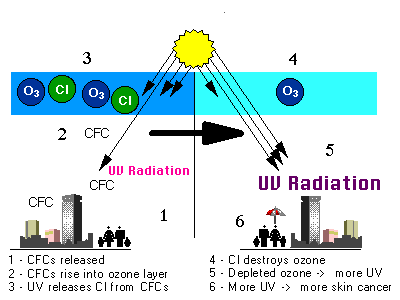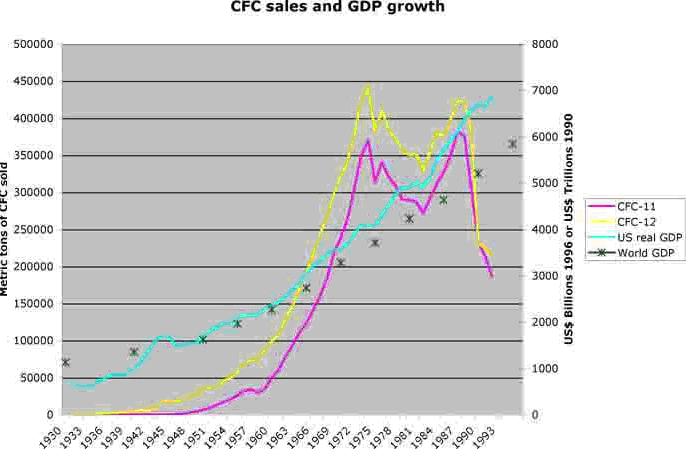A Fragile Layer of Protection
The atmospheric ozone layer evolved over billions of years, covering the earth with a thin layer of ozone molecules some 20 to 30 kms  about the earth’s surface. This layer provided protection from the sun’s harmful Ultraviolet (UV-B) radiation, making complex life on earth possible. A natural cycle of ozone creation and destruction evolved which provided just the right conditions for complex living organisms.
about the earth’s surface. This layer provided protection from the sun’s harmful Ultraviolet (UV-B) radiation, making complex life on earth possible. A natural cycle of ozone creation and destruction evolved which provided just the right conditions for complex living organisms.
The development of man-made chlorofluorocarbons (CFCs) in the 1930’s upset this delicate balance by destroying atmospheric ozone molecules faster than they could be naturally regenerated to maintain the ozone layer at a thickness sufficient to protect living organisms.
Economic interests led to the rapid expansion of CFCs and other new ozone depleting compounds, and in just a few years produced a hole in the atmospheric ozone layer at the earth’s poles, as well as thinning the ozone layer above the earth’s temperate zones. Increased UV-B radiation on the earth’s surface led to a number of harmful effects for humans, plants and animals.
These features of the atmospheric ozone story identify the scale relevant characteristics of the phenomenon. Economic throughput (in the form of ozone depleting compounds) exceeded the regenerative capacities of an ecosystem (the natural production and destruction of atmospheric ozone) to maintain the thickness of the atmospheric ozone layer needed to provide a critical service (protection from harmful radiation). Whenever throughput exceeds the regenerative capacities of a critical ecosystem, sustainable scale is exceeded (see Sustainable Or Unsustainable). When a critical ecosystem service is degraded, considerable harm occurs.
This is precisely what happened with ozone depleting compounds over a relatively short time period of a few decades; human economic activity associated with these compounds disrupted a critical and irreplaceable life support system that had evolved over billions of ears. In some places there was over a 60% reduction in the thickness of the atmospheric ozone layer. If the problem had not been detected in time the atmospheric ozone layer may have been disrupted beyond repair (see Unsustainable Scale), jeopardizing almost all living organisms on the earth’s surface.
Consequences of Exceeding Sustainable Scale
Once sustainable scale is exceeded two important phenomenon occur.
-
a decline in
natural capital occurs (see
Natural Capital and Income); in the present case the atmospheric ozone layer became thinner and is therefore no longer able to provide the same level of service (UV-B protection) it formerly did
-
the resilience of the system, its capacity to return to the original equilibrium state, is degraded.
In general, we know that the resilience of complex systems is diminished the further the system is pushed from its equilibrium state. Resilience is also diminished the longer it remains beyond this point. Therefore the longer or further the atmospheric ozone layer is pushed beyond sustainable scale, the less resilient the system is likely to be in the future, and the less likely is the system ever to be able to provide the same level of service it previously did. Furthermore, the degradation of resilience is typically non-linear; the longer or further a system is from its equilibrium state, the more likely are “surprises” to occur.
When we are dealing with a critical life-support system like atmospheric ozone, such surprises are to be avoided. The science regarding the atmospheric ozone layer’s resilience may not be certain, but the only way of knowing with certainty that resilience is declining is waiting for it to happen. If this occurs, it may not be possible to reverse the degradation of resilience, leading to a total collapse of the system (see Unsustainable Scale). Ensuring that we return to sustainable scale for atmospheric ozone as quickly as possible, and stay there, is a vital application of the precautionary principle.
Sustainable Scale: Economic Throughput Relative to Ecosystem Regeneration
The economic activities associated with ozone depleting compounds had an impact on sustainable scale in at least two ways. First of all, these new compounds were a great improvement over the more dangerous refrigerants previously in use (toxic gases, ammonia (NH3), methyl chloride (CH3Cl), and sulfur dioxide (SO2)). This led to rapidly increasing sales of these new compounds to replace the older, substances know to be dangerous. In and of itself this level of economic throughput challenged the capacity of the atmosphere to absorb these new compounds and resulted in thinning of the atmospheric ozone layer. 
The introduction of these substances had a second indirect but equally important impact on ecosystem functioning. With the advances these compounds made possible in terms of refrigeration of foods and medicines, as well as air conditioning, human development spread to areas previously too uncomfortably hot to attract major settlements. This spread of human infrastructure added significantly to the total economic throughput, over and above that added specifically by the sale of ozone depleting compounds. This increased development destroyed habitat, consumed more fossil fuels in construction and ongoing transportation, and generally contributed to the degradation of ecosystems in previously unsettled areas (e.g. Florida) and beyond.